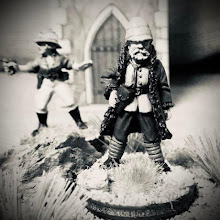Honorable Son #5 and myself took a weekend trip to the Shiloh National Military Park for some history, camping and fellowship. I have led at least 5 staff rides of the battle, fought the battle in miniature twice and have walked this ground more than any other battlefield I have visited. Nearly 110,000 American troops clashed in a bloody contest that resulted in 23,746 casualties; more casualties than in all of America's previous wars combined. I gave Honorable Son #5 a history lesson, but what fascinated us most this time around were the monuments to units, States and men from this war where brother fought brother.
Three armies fought at Shiloh:
Congress established Shiloh National Military Park on December 27, 1894 to commemorate the April 6-7, 1862 battle that raged around Shiloh Church and Pittsburg Landing. Producing more than 23,000 casualties, the battle was the largest engagement in the Mississippi Valley campaign during the American Civil War. Originally under the War Department, Shiloh National Military Park was transferred to the National Park Service in the Department of the Interior in 1933. Currently, the park has over 4,200 acres. Veterans from both sides came together to help mark the battlefield with unit locations:
Some of the flags displayed in the Visitor's Center:
There are many ways to view the battlefield with a great driving tour and many walking trails. Considering it was Tennessee and about 95 degrees (35 Celsius) we decided on the driving tour. The driving tour is 12.7 miles with 20 tour stops at such famous places as the Peach Orchard, the Hornest Nest and the site of General Albert Sidney Johnston's death.
The Iowa monument.
Iowa monument from the other side.
The Confederate Memorial at Shiloh.
At the extreme right, the figure in front represents the Confederate infantryman who has snatched up his flag in defiance of the Northern army. The figure to his rear is the artilleryman, who is calm as he appears to gaze through the smoke of battle.
To the left, the figure in front represents the cavalryman. His hand is spread, indicating frustration. He is eager to help, but cannot penetrate the heavy undergrowth. The figure back of the cavalryman represents the officers of the Confederate army. He has his head bowed in submission to the order to cease firing when, it seemed, had it not been given the first day, there might have been a Confederate victory.
The central group represents a "Defeated Victory." The front figure, representing the Confederacy, is surrendering the laurel wreath of victory to Death, on the left, and Night, on the right. Death came to their commander and Night brought reinforcements to the enemy, and the battle was lost.
The panel of heads on the right represents the spirit of the first day. How hopefully and fearlessly the 11 young Confederates rushed into battle! The panel of heads on the left represents the second day of the battle and the sorrow of the men, now reduced to 10, over the victory so nearly won and so unexpectedly lost.
Looking across Duncan Field from the end of the sunken road just shy of the Hornet's Nest.
Looking down the sunken road from the Union left to the right. It was hard to throw a rock without hitting a monument to the troops from Iowa, Illinois or Indiana.
When infantry attacks against the Hornet's Nest failed, the Confederates concentrated 11 batteries of artillery to bombard the position.
Cannons positioned on the other side of Duncan's field. Estimates are that there were 55 guns massed to fire at the Union positions on the Sunken Road and the Hornet's Nest. Honorable Son #5 and myself counted 36 cannons that the Park Service has placed on the site of the concentration.
Honorable Son #5 is 5 feet, 5 inches tall (1.651 meters) to give you an idea of the scale of the guns. I'm going to have to start checking the scales of the guns I purchase!

































Hi Neil, Thank you so much for posting pics of your trip to Shiloh. What an amazing place, and so well preserved too. That is a superb collection of Artillery they have in the park. I am well overdue a trip to the States - looks like I really should add a visit to Shiloh to my list.
ReplyDeleteBest wishes,
Jason